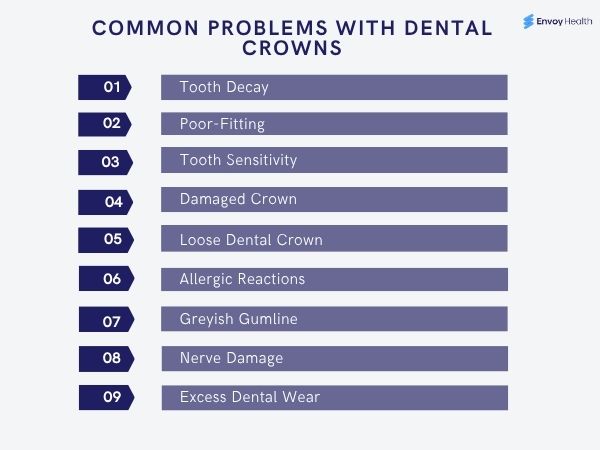Dealing With Problems With Dental Crowns Isn’t Fun: Here’s How To Handle It

Prathyusha Itikarlapalli
- Content Writer

XAVIER PRIMO PAVÓN
- Reviewed by

Key Takeaways
- Dental crowns are designed to last for 5 to 15 years. However, certain factors, including poor oral hygiene, teeth grinding (bruxism), or improper placement, can shorten their lifespan and impact comfort.
- Warning signs of crown-related issues include lingering sensitivity, pain while chewing, a crown that feels loose, or dark lines near the gum; these may signal infection, decay, or fit issues.
- While most problems with crowns are fixable, timely intervention is key. Depending on the cause, treatment may involve recementing, reshaping the crown, replacing it, or performing a root canal to protect the underlying tooth.
Tooth Cap vs Crown: A Brief
Ideally speaking, there isn’t a significant difference between the two. While some people refer to dental crowns as “tooth caps,” both terms describe the same thing: a custom-made restoration to cover and protect a damaged or weakened tooth. The term "crown" is more commonly used in clinical settings, whereas "cap" is often used in everyday conversations.
Stepping into the details, dental crowns are tooth-colored caps that serve as replacements for natural teeth, aiding in daily activities such as chewing, eating, and talking more effectively. In short, a dental crown restores the shape and size of a tooth, providing strength and bite force. With its natural hue and shade, it also improves the aesthetics. However, not all crowns appear white colored. Dental crown costs vary with the material they are made from. Those made from dental ceramics, such as porcelain or zirconia, appear white in color. However, those crafted from materials like stainless steel or metal alloys carry a distinct appearance specific to the material. While the appearance of dental crowns varies depending on the material, so do their costs and benefits. Your dentist will elaborate on the pros and cons of the types of dental crowns and cost specific to your case.
Dental crowns are, in fact, a successful procedure with longer survival periods of around 5-15 years, provided they are well cared for.[1] However, crown placement rarely leads to problems and discomfort in some candidates. While the causes can be diverse, their negative impact is real. Below, we have briefed on the most common problems with tooth crowns and the effective treatment methods.
Common Problems With Dental Crowns and Effective Ways To Deal With Them
Below are the common dental problems with crowns.
Tooth Decay
Tooth decay after a crown procedure is one of the most common problems with old dental crowns. This occurs when oral bacteria multiply their number near the edge of the crown, where the crown meets the tooth, or are located beneath the crown (between the inner surface of the crown and the existing tooth piece). Bacteria naturally prevail within the oral cavity. They feed on the food debris and trapped food particles. When oral hygiene is compromised, these bacteria remain on the teeth, infecting the surrounding tooth structures. Symptoms include intense pain, sensitivity, swollen gums, and loosened crown (in some cases).
How To Treat Tooth Decay Caused Due to Dental Crowns?
Dentists will remove the crown, clean the tooth decay, and remove the infected portion of the tooth. They will replace a new one to restore the natural functioning.
Poor-Fitting Dental Crown
A successful dental crown should fit snugly on the tooth structure. It's not loose or leaves gaps, and has rough edges on the sides. Bad-fitting crown symptoms include sensitivity, discomfort, gum irritation, visible awkward gaps, and an uneven bite. If you're someone who’s worried, the crown feels weird when I bite down. Note that it could be because it lacks a proper fit. And the reasons include improper cementation, inaccurate crown fabrication, or improper impression collection. Are you wondering what this means? Let's walk you through the dental crown procedure. Dental crowns are custom-fit caps crafted in a dental lab. No crown is a one-size-fits-all. Your dentist will prepare the natural tooth so it anchors the crown. They collect the impressions using putty or through digital means and send them to the dental lab for crown fabrication. Dental lab technicians craft customized crowns utilizing advanced technology, including CAD/CAM. These crowns are now cemented on your tooth using dental adhesive.
A common question patients ask is: “Is the dentist responsible for failed crown?” The answer depends on where the process broke down. In most cases, an ill-fitting crown is the result of one or more errors during the impression, crafting, or fitting phases.
How To Treat a Poor-Fitting Dental Crown?
Dentists suggest readjusting the crown's fit and shape so that it holds the tooth securely without a gap.[2] They may also advise recementing it, using a stronger dental adhesive, especially in cases when the dental cement has deteriorated. In rare cases, dentists consider crown replacement when there's severe tooth decay or crown damage due to a poor fit.
Tooth Sensitivity
Tooth sensitivity due to dental crowns presents as a tingling sensation upon exposure to hot, cold, and acidic foods. It's normal to experience sensitivity after a few days following a crown procedure. This occurs due to tissue inflammation, so dentists generally advise chewing on the other side or avoiding hot and cold foods immediately after a crown procedure. However, a persisting sensitivity for a few weeks indicates underlying nerve damage or dentin exposure. A crown is fixed on a prepared tooth structure, where dentists file down the outer enamel to some extent. Excessive filing may damage the nerve or expose the sensitive dentin layer, causing tooth sensitivity.[3] So when you ask us, how much tooth is needed for a crown?, dentists remove only a small portion of the enamel to make room for the crown. They leave at least 2mm of the tooth structure to leave the dentin undisturbed. In some cases, a progressing dental infection beneath the crown surface can cause tooth sensitivity.
How To Treat Tooth Sensitivity Due to Dental Crowns?
A warm saltwater rinse, or desensitizing toothpaste, works during the initial days. However, if it still persists, dentists will recommend a mouthguard or root canal treatment based on the exact cause of the issue. Mouth guards serve as a protective barrier, reducing pressure and preventing further damage. If it's due to alignment issues, they correct the positioning to address the bite issues. However, if the sensitivity is due to an advancing infection, dentists perform root canal treatment.
Damaged Crown
While most modern crowns are made from durable materials that last longer, a few may chip, break, or develop cracks. In most cases, it cannot be a fault in the material or treatment, but rather a result of improper crown maintenance. Materials like zirconia or metal alloys are highly tough. However, in rare cases, they may break when you bite down on hard foods (such as candies or ice). This is particularly true with problems with porcelain crowns. Porcelain, although a popular dental material, is recommended for front teeth crowns. Durable zirconia or metal alloys are used for back teeth crowns as they experience a harder grinding force due to the actions of chewing. Chipping also occurs when you have habits such as teeth clenching or grinding, where exerting force can lead to chipping. Other conditions that can damage the crowns include accidents, trauma, or general wear and tear. Damage due to wear and tear is a more common problems with old dental crowns. The crown's lifetime is defined by its material strength and the limitations it imposes. After the specified timeline, most crowns require replacement; otherwise, candidates may notice a worn-out crown developing chips and cracks.
How To Treat a Damaged Crown?
When you notice a damaged crown, stop chewing on that side of the jaw. See your dentist so they can conduct a thorough examination to know the extent of the damage. They use dental X-rays for this. Based on the obtained results, dentists perform bonding for minor chips. However, if it's a major crack, a crown replacement is required.
Loose Dental Crown
A loose dental crown appears unstable, shifting, or moving, which generates a sense of discomfort and sensitivity. It can even generate a sharp pain when you bite down on hard foods. This usually happens when the dental cement holding the crown deteriorates due to normal wear and tear over time. This is especially common in cases where candidates are prone to habits such as bruxism or teeth clenching, or have tooth decay under the crown surface. In others, the crown may become loose due to improper fabrication, resulting in a poor fit.
How Is a Loose-Fitting Dental Crown Treated?
Your dentist will evaluate the exact cause of your loose crowns. If it's due to a poor fit or lost dental cement, they consider reinstalling the same crown using a more effective dental cement. However, if it's due to tooth decay, they remove the existing crown, treat the tooth infection, and refix a new, perfectly fitting crown.
Allergic Reactions
Although dental crowns are associated with minimal side effects, a few materials used for their fabrication have the potential to elevate an allergic reaction. Crown material, particularly metals such as nickel or cobalt, or the dental resins and cement used to secure the crown over the tooth, can cause an allergy in a few individuals. Symptoms of allergy due to the crown include oral inflammation, redness, itching, or swelling. A severe allergy may also lead to skin rashes, a burning sensation with itching around the mouth.
How To Treat an Allergy Due to a Dental Crown?
Dentists need to assess the cause of the allergic reaction. Whether it's the metal, composite resin, or dental cement. They conduct a patch test to diagnose the root cause. Minor allergic symptoms are typically resolved with the use of antihistamines. Severe allergies require alternative treatment and crown replacing. It's better to disclose any previous history of allergies before undergoing dental crown treatment. This will help choose the suitable dental crown type.
Greyish Gumline
In some patients, the gum tissue around the crown recedes (pulled back), showing the metal color of the crowns. This typically appears as a greyish gumline around the crown and is more common in metal crowns. Grey gums after dental crown treatment are more of an aesthetic concern.
How To Treat Grey Gums Caused by a Dental Crown?
Dentists prefer replacing metal crowns with full porcelain crowns that match the hue of natural teeth. Excessive greyish gums may require treatments such as gum bleaching or depigmentation, which use lasers or microdermabrasion. This will remove the excess pigment, offering the natural pinkish hue.
Nerve Damage
The nerve portion that performs the sensory functions is enclosed within the pulp (soft tissue) of the tooth. The outer enamel and dentin layers act as a protective covering. However, in cases of tooth decay or dental injuries, such as chips or cracks, the pulp portion gets damaged. Dental crowns causing nerve damage may present as tooth sensitivity to hot and cold foods, as well as intense and persistent pain while chewing and biting. While these may seem similar to tooth sensitivity, one can distinguish them based on their intensity. Sensitivity lasts for only a few seconds, while the pain due to nerve damage remains persistent and may even worsen over time. Further, nerve damage pain sometimes does not require a trigger, such as hot or cold foods.
How To Treat the Nerve Damage Due to a Dental Crown?
Dentists will first identify the cause of nerve damage. They perform root canal treatment to alleviate nerve pain caused by tooth infection. However, if the nerve damage is due to inappropriate crown placement, dentists consider readjusting the crown. For candidates where nerve damage is due to a chipped or broken crown, they consider replacing the existing crown with a new, custom-fit crown.
Excessive Dental Wear
The dental crown material, when it's exceptionally harder, poses accelerated wear and tear to the teeth in the opposite jaw. This is one of the more common problems associated with front teeth crowns, particularly in individuals with habits such as bruxism. The habits of clenching teeth exert pressure on the opposing teeth, causing excessive wear and tear. Furthermore, a malaligned crown does not fit exactly into the space, resulting in improper pressure distribution when you chew or bite. Additionally, candidates who have received dental crown treatment are advised to avoid biting on hard nuts, ice, or candies. This may lead to loss of crown functionality, chips, breaks, and tooth sensitivity.
How Is the Dental Wear Caused by Crowns Treated?
Dentists consider replacing the worn-down crown, as leaving them as such may lead to further damage to the underlying natural teeth. Suppose the wear and tear is at its initial stages, you may be recommended to use a night guard. This applies especially for candidates prone to habits like bruxism.

Busting One of the Most Asked Myths: Can Dental Crowns Cause Cancer?
According to studies, receiving dental crown treatment does not increase the risk of cancer. Dental crowns are, in fact, a safe procedure with slight or less serious complications. The side effects are minimal and cause some discomfort. But the point that crowns lead to cancerous conditions is purely a myth. Tobacco usage and excessive alcohol consumption are the most common causes of oral cancers.
Preventing the Common Problems With Tooth Crowns
One can adopt effective oral hygiene, limit their reliance on hard foods, and get the scheduled dental check-ups in order to prevent the common problems caused by dental crowns. Below are a few steps you can follow in this regard.
- Brush your teeth two times a day and floss them regularly.
- Use antibacterial mouthwash to reduce plaque and tartar formation.
- Avoid biting on hard ice and candies and opening food packets with teeth.
- Cut down on the hard (candies, nuts, crackers), sugary, and sticky foods (jellies, caramel).
- Use a mouth guard to limit the potential harm caused by teeth grinding.
- Attend the regular dental check-ups and cleaning sessions to maintain a healthy oral cavity.
Last but never least, choose high-quality dental materials for your crown treatment. While less expensive fixes may seem appealing, their long-term effects should not be neglected. Opt for the durable materials like porcelain, zirconia, or metal alloys as they are popular choices with the least complications.
Final Word!
While most dental crowns serve their purpose well for years, occasional issues can arise. From discomfort and sensitivity to poor fit and crown damage, problems with dental crowns are often the result of procedural errors or improper aftercare. But, the good news is that they’re usually treatable. The key is early detection and access to trusted dental professionals who can fix the problem before it worsens.
If you’re dealing with crown-related concerns or want expert help abroad without the wait or high costs, Envoy Health connects you with top-rated, vetted clinics that specialize in restorative dental care. Sign up now and let us help you navigate your dental journey with confidence.
References
Disclaimer
The information in this article is for educational purposes only and does not replace medical advice. Always consult your doctor before starting any treatments.
Damaged dental crowns should be replaced as soon as the failure is detected. Failing to replace a damaged crown can lead to further tooth decay, gum disease, and even tooth loss.
Dental crowns can last 5-10 years when properly cared for. While replacement is generally recommended after this period, it’s not a strict rule. Crowns can be replaced at any time if they develop chips, cracks, or other signs of damage.
The downside of getting dental crowns is the preparation procedure required. Dentists need to scrape down the enamel in order to make room for the upcoming crown. This removal of tooth enamel can lead to tooth sensitivity in some patients.
A dental crown that hurts can be due to various reasons, such as nerve damage, tooth decay, or chipping of the crown. Your dentist will examine the symptoms and evaluate the condition of your tooth to determine the cause of the toothache.
While porcelain crowns are popularly chosen, they pose a problem of developing chips and cracks and are relatively less durable. For this reason, porcelain crowns are not recommended for the back teeth. Dentists advise getting porcelain crowns for the front teeth that are prone to less wear and tear.
A malaligned or poorly fitted dental crown can lead to temporomandibular joint disorder, leading to jaw joint pain and discomfort. The temporomandibular joint connects your jaw to the skull, and improper crown positioning can alter the bite, resulting in uneven pressure in the jaw. Symptoms range from headache, jaw pain, and difficulty chewing.
So, we partner with the premier healthcare facilities!
Send me the list




